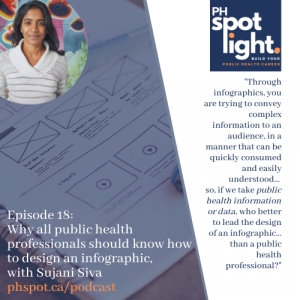
Infographic design: keep it simple to get started
When you think about designing your very first public health infographic, you can keep it simple. In this blog post, we want to show you
Infographics (/ˌinfōˈɡrafik/ | noun.) are the visualization of data or ideas.
The process of developing and publishing infographics is “data visualization”, “information design”, or “information architecture”. It is the detailed planning of specific information that is to be provided to a particular audience to meet specific objectives. The goal of information design is to help humans process information as efficiently as possible.
Through the use of infographics, you are trying to convey complex information to an audience in a manner that can be quickly consumed and easily understood.
On this page, you’ll find:
These articles, tutorials, and case studies will help you
in your journey of designing infographics in public health.
VIEW ALL ARTICLES ON INFOGRAPHICS

When you think about designing your very first public health infographic, you can keep it simple. In this blog post, we want to show you

This blog post is a part of our mini-series to bring you quick tips to ensure your infographic design projects are a success! Infographics can be a

This blog post is a part of our mini-series to bring you quick tips to ensure your infographic design projects are a success! The beginning of the

This blog post is a part of our mini-series to bring you quick tips to ensure your infographic design projects are a success! Infographics can be a

During graduate school, I wanted to spend time doing something that was going to make a difference and be important in the world. So, how

Your audience is increasingly time-pressured nowadays, and this is in part because we receive more information than ever before. Some sources say that the numbers are
Interested in designing your own public health infographics but not sure how to get started? Use these resources to get started.

This year, January 14th to be exact, PH SPOT celebrates 5 years. It’s unbelievable that 5 years have gone by already. Sujani created PH SPOT

Show Notes After writing the Opinion piece on the PH SPOT blog, The rise of infographics, and why I believe all public health professionals should
Infographics (/ˌinfōˈɡrafik/ | noun.) are the visualization of data or ideas.
The process of developing and publishing infographics is “data visualization”, “information design”, or “information architecture”. It is the detailed planning of specific information that is to be provided to a particular audience to meet specific objectives. The goal of information design is to help humans process information as efficiently as possible.
Through the use of infographics, you are trying to convey complex information to an audience in a manner that can be quickly consumed and easily understood.
Yes! Download this free guide: 4 ways to use infographics in your public health work (+ a list of ideas for each of the 4 ways!)
As a public health professional, our responsibility is to effectively communicate findings to our audiences.
Today, we (along with our audience) receive more information than ever before – some sources say that the numbers are as high as 100,000+ words per day, and this doesn’t include what people consume at work! Getting through all of this noise, and effectively communicating your public health message (whether it’s to the public, senior management, or stakeholders of a project) is extremely important. We would even go as far as saying that as a public health professional, it is our responsibility to ensure that quality public health information is translated in a way that is easily consumable by population groups we serve and deeply care about. And if you haven’t guessed it, this is where infographics come in!
Infographic design requires the use of a number of concepts including psychology, data science, and graphic design, but in our opinion, that’s not to say that only specialists in those areas can design them.
Public health professionals are in a unique position as content experts to lead infographic design projects. They just need to know some basic concepts, the available tools/resources, and how to execute the design process.
You can use a number of software to design infographics. Some of the popular ones are Adobe Creative Suite (i.e. Illustrator), Canva, or Venngage.
The software we love to use for infographic design is MS PowerPoint. (Yes, MS PowerPoint is not meant to be a design software, but simple software are more than enough to design infographics.)
This is also the software we teach in our course! The Infographics 101 course is for beginners and aims to teach infographic design using software that is already available to public health professionals (instead of investing in new/expensive ones). We have found that great infographics can be designed using PowerPoint.
There are 9 simple steps to designing an infographic. Starting with understanding your objective, and intended audience; then building your story and vision; drafting out the first version of it; pulling it all together by collaborating with your stakeholders; and finaly designing your infographic. You can download the guide here.
A “layout” is the arrangement of your visual elements and content. Since infographics tell a story, ensuring you select the best layout to effectively (and efficiently) tell your story is important. There are 6 major infographic layouts: statistical, process, timeline, comparison, geographical, text-based & a combination of multiple core layouts.
Founded in 2017, PH SPOT is a career development platform for public health professionals around the world.